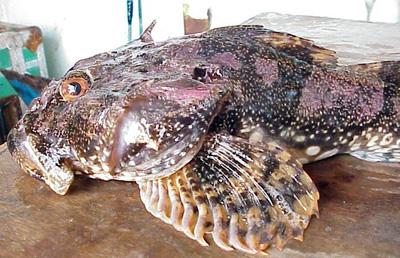Commonly caught by recreational harvesters in Puget Sound. Caught incidentally in the commercial fishery off the outer Washington coast.
Description and Range
Physical description
The body of the great sculpin is dark olive green on the dorsal surface with four dark saddles along the back. The belly is pale, often white or yellowish, and there are dark bars along the fins. It has a large, elongated head and large eyes. The spinous and soft dorsal fins are separated and there are 9-10 dorsal spines and 13-16 dorsal soft rays. This species lacks an anal spine. The distinguishing characteristics of this species are; a single long, strait spine on each preopercular bone that does not extend past the end of the gill plate; and scales on the head that appear as fleshy nodes (papilla).
Great sculpin can grow up to 80 cm (31.4 in) in length, and 9 kg (19.8 lbs) in weight. Maximum age is at least 16 years old.
Geographic range
Great sculpin are common from the Bering Sea to Washington. Their range extends through the Aleutian Island chain, to the Kamchatka Peninsula, to northern Japan. They are found over sandy and muddy bottom from the intertidal to water depths of 240 m (787 ft).
State record
- Weight
- 4.60 lbs
- Angler
- Mark Reynolds
- Location
- Port Angeles Harbor, Clallam County
- Date Caught
- July 29, 1999
